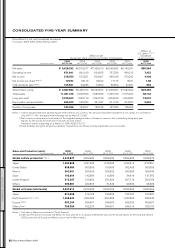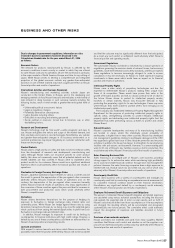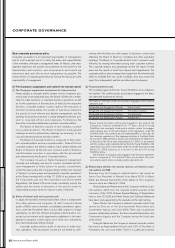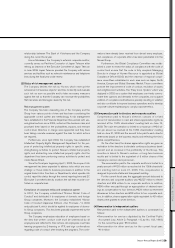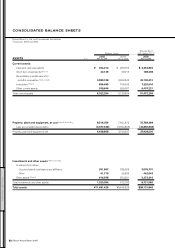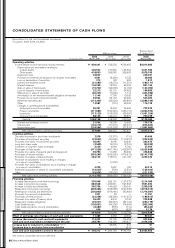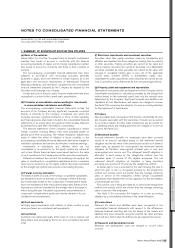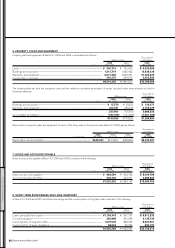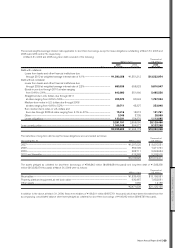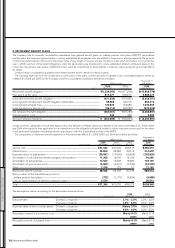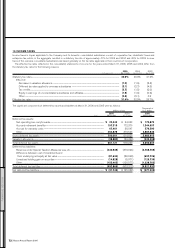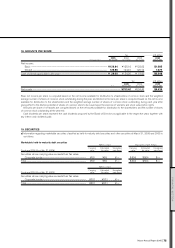Nissan 2006 Annual Report Download - page 68
Download and view the complete annual report
Please find page 68 of the 2006 Nissan annual report below. You can navigate through the pages in the report by either clicking on the pages listed below, or by using the keyword search tool below to find specific information within the annual report.
(l) Revenue recognition
Revenue is generally recognized on sales of products at the time of
shipment.
(m) Derivative financial instruments
The Company and certain consolidated subsidiaries have entered into
various derivative transactions in order to manage certain risk arising
from adverse fluctuation in foreign currency exchange rates, interest
rates, and stock and commodity prices. Derivative financial
instruments are carried at fair value with changes in unrealized gain or
loss charged or credited to operations, except for those which meet
the criteria for deferral hedge accounting under which unrealized gain
or loss is deferred as an asset or a liability. See Note 2 (e).
(n) Appropriation of retained earnings
Under the Commercial Code of Japan, the appropriation of retained
earnings with respect to a given financial year is made by resolution
of the shareholders at a general meeting held subsequent to the
close of such financial year. The accounts for that year do not,
therefore, reflect such appropriations. See Notes 10 and 22.
(o) New Accounting Standards
In December 2005, the Accounting Standards Board of Japan issued
a new accounting standard for stock options. This accounting
standard requires companies to recognize expenses related to stock
options at fair value as of their grant dates over the respective vesting
periods. The new accounting standard applies to stock options
granted on and after May 1, 2006. The Company is currently
assessing the impact of the adoption of this standard on its
consolidated financial statements.
Nissan Annual Report 2005
66
FINANCIAL SECTION
2. ACCOUNTING CHANGES
(a) Until the year ended March 31, 2003, finished goods, work in
process and purchased parts included in raw materials were stated at
the lower of average cost or market, and raw materials except for
purchased parts and supplies were stated at the lower of cost or
market, cost being determined by the last-in, first-out method.
Effective April 1, 2003, the Company and certain consolidated
subsidiaries began valuing all inventories at the lower of cost or
market, cost being determined by the first-in, first-out method. This
change was made in order to establish a sound financial position by
reflecting the changes in the purchase prices and in the valuation of
inventories considering the fact that there had been progress in
achieving a reduction in purchasing costs and that this trend is
anticipated to continue. This change was also intended to achieve a
better matching of revenue and expenses and more appropriate cost
management by applying an inventory valuation method which
reflected the actual inventory movements. The effect of this change
was immaterial for the year ended March 31, 2004.
(b) Effective April 1, 2003, Nissan Motor Manufacturing (UK) Ltd., a
consolidated subsidiary, implemented early adoption of a new
accounting standard for retirement benefits in the United Kingdom.
The effect of this change was to increase retirement benefit
expenses by ¥2,178 million and to decrease operating income and
income before income taxes and minority interests by ¥1,686 million
and ¥2,178 million, respectively, for the year ended March 31, 2004
as compared with the corresponding amounts which would have
been recorded if the previous method had been followed. Retained
earnings also decreased by ¥18,132 million since the net retirement
benefit obligation at transition and actuarial loss was charged directly
to retained earnings for the year ended March 31, 2004. The effect
of this change on segment information is explained in Note 21.
(c) Until the year ended March 31, 2003, noncancelable lease
transactions of the Company and its domestic consolidated
subsidiaries were accounted for as operating leases (whether such
leases were classified as operating or finance leases) except that
lease agreements which stipulated the transfer of ownership of the
leased assets to the lessee were accounted for as finance leases.
Effective April 1, 2003, the Company and its domestic
consolidated subsidiaries changed their method of accounting for
noncancelable lease transactions which transfer substantially all risks
and rewards associated with the ownership of the leased assets to
the lessee, from accounting for them as operating leases, to finance
leases. This change was made in order to achieve a better matching
of revenue and expenses by calculating manufacturing costs more
accurately and to establish a better presentation of the Company's
and its domestic consolidated subsidiaries’ financial position by
reflecting lease transactions more appropriately in its consolidated
financial statements, considering the increasing materiality of these
lease transactions as well as from an international point of view.
The effect of this change in method of accounting was to decrease
sales, cost of sales, and selling, general and administrative expenses
by ¥17,943 million, ¥38,910 million and ¥624 million, respectively,
and to increase operating income and income before income taxes
and minority interests by ¥21,591 million and ¥17,659 million,
respectively, for the year ended March 31, 2004 as compared with
the corresponding amounts which would have been recorded if the
previous method had been followed. The effect of this change on
segment information is explained in Note 21.
(d) Until the year ended March 31, 2004, freight and shipping costs
of the Company and certain consolidated subsidiaries were included
in selling, general and administrative expenses. Effective April 1, 2004,
the Company and those consolidated subsidiaries began accounting
for freight and shipping costs as cost of sales. This change was made
in order to present gross profit more accurately by including freight
and shipping costs in cost of sales and matching them directly with
sales as well as to unify the accounting policy within the Nissan
group considering the fact that shipping costs for export parts to be
used for manufacturing in overseas countries have increased due to
the expansion of manufacturing activities outside Japan.
The effect of this change was to increase cost of sales by
¥112,074 million and to decrease gross profit and selling, general
and administrative expenses by the same amount for the year ended
March 31, 2005. This change had no impact on operating income,
income before income taxes and minority interests, and net income
for the years ended March 31, 2005 as compared with the


